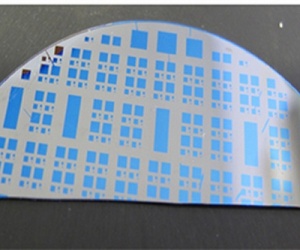Silicon memristors promise cheaper, faster, denser memory
First silicon oxide resistive ram operates at room temperature, cheap as chips.


University College London researchers have detailed what it claims to be the world's first silicon oxide-based resistive RAM (ReRAM) that can run at room temperature.
ReRAM is one of the technologies researchers are developing that could replace traditional NAND flash for non-volatile storage systems, offering speeds far closer to that of volatile dynamic RAM (DRAM) modules.
Previous ReRAM prototypes, including a headline-grabbing example from 2008 which was based on titanium dioxide and Eplida's recently-announced module which is due for mass production in 2013, have required esoteric operating environments - including vacuums and extreme temperatures - and complex production processes which have precluded them from commercialisation.
According to the team's work, published in the Journal of Applied Physics, the solution may have been found with the first ReRAM module to be produced from common silicon oxide and to operate at ambient temperatures - heralding a potential revolution in high-speed storage systems.
"Our ReRAM memory chips need just a thousandth of the energy and are around a hundred times faster than standard flash memory chips," boasted Tony Kenyon of his team's findings. "The fact that the device can operate in ambient conditions and has a continuously variable resistance opens up a huge range of potential applications."
The prototype system is capable of switching resistance significantly more efficiently than any other ReRAM prototype around, thanks to a novel silicon oxide structure whereby the arrangement of silicon atoms changes to form filaments of silicon within the solid silicon oxide. These filaments are significantly less resistive than the filament-free silicon oxide, providing the one to their absence's zero required for digital storage.
The ReRAM prototype could also be used to produce memristor hardware which mimics the neurons in the brain, thanks to its ability to record a continuously variable resistance based on the last voltage that was applied.
Get the ITPro daily newsletter
Sign up today and you will receive a free copy of our Future Focus 2025 report - the leading guidance on AI, cybersecurity and other IT challenges as per 700+ senior executives
Amusingly, the material was discovered by accident. During work on producing silicon-based light-emitting diodes (LEDs), researchers noted that the prototype devices appeared unstable. Adnan Mehonic, a PhD student, was asked to investigate - and found that, far from being unstable, the material the team had created flipped between conductive and non-conductive states extremely predictably.
"My work revealed that a material we had been looking at for some time could in fact be made into a memristor," Mehonic explained at the material's unveiling. "The potential for this material is huge. During proof of concept development we have shown we can program the chips using the cycle between two or more states of conductivity. We're very excited that our devices may be an important step towards new silicon memory chips."
The team is keen to point out the material's potential for high-speed non-volatile memory systems, memristor applications and even for use as a central processor - but, as is often the case with academia, is somewhat silent on a potential release date for a commercialised version of the technology.
Gareth Halfacree is an experienced tech journalist and IT professional, and has been writing since 2006. In addition to contributing article for ITPro, Gareth has been featured in publications such as PC Pro, Techmeme, The Register, The MagPi, and Tom’s Hardware.
In addition to his digital articles, Gareth is the author of several best-selling books. These include the Raspberry Pi User Guide, an essential text for those looking to get started with their Raspberry Pi, as well as The Official Raspberry Pi Beginner’s Guide. Gareth also wrote the Official BBC micro:bit User Guide, a comprehensive guide to setting up the pocket-sized computer, learning to code on it, and even creating your own hardware addons.
-
 Should AI PCs be part of your next hardware refresh?
Should AI PCs be part of your next hardware refresh?AI PCs are fast becoming a business staple and a surefire way to future-proof your business
By Bobby Hellard Published
-
 Westcon-Comstor and Vectra AI launch brace of new channel initiatives
Westcon-Comstor and Vectra AI launch brace of new channel initiativesNews Westcon-Comstor and Vectra AI have announced the launch of two new channel growth initiatives focused on the managed security service provider (MSSP) space and AWS Marketplace.
By Daniel Todd Published
-
 Synology FlashStation FS3400: Same old, same old
Synology FlashStation FS3400: Same old, same oldReviews Synology’s latest SMB all-Flash appliance gets a rebadge but no upgrade
By Dave Mitchell Published
-

 Infortrend EonStor GSa 2024RC review: The all-Flash host with the most
Infortrend EonStor GSa 2024RC review: The all-Flash host with the mostReviews Infortrend shows the blue-chips how it’s done
By Dave Mitchell Published
-
 Synology FlashStation FS2017
Synology FlashStation FS2017Reviews Synology’s FS2017 brings all-flash storage down to a price point SMBs will like
By Dave Mitchell Published
-

 Fujitsu Storage Eternus AF250
Fujitsu Storage Eternus AF250Reviews Exclusive: Fujitsu brings the price of all-flash storage to an all-time low
By Dave Mitchell Published
-
Waitrose chooses Pure Storage to reduce datacentre footprint
News Flash storage solution promises speed and storage boost for supermarket demand forecasting application
By Clare Hopping Published
-
 EMC accuses former staff of taking trade secrets to rival Pure Storage
EMC accuses former staff of taking trade secrets to rival Pure StorageNews Storage giant sues former employees that have left to work for competitor.
By Caroline Donnelly Published
-
 EMC treats VNX range to a Flash storage injection
EMC treats VNX range to a Flash storage injectionNews Storage giant uses Speed2Lead event to announce arrival of new Flash-optimised storage arrays.
By Caroline Donnelly Published
-
 Crossbar claims high capacity memory cuts a dash as a flash replacement
Crossbar claims high capacity memory cuts a dash as a flash replacementNews Memory vendor claims to have put 1TB on a chip that's smaller than a postage stamp.
By ITPro Published